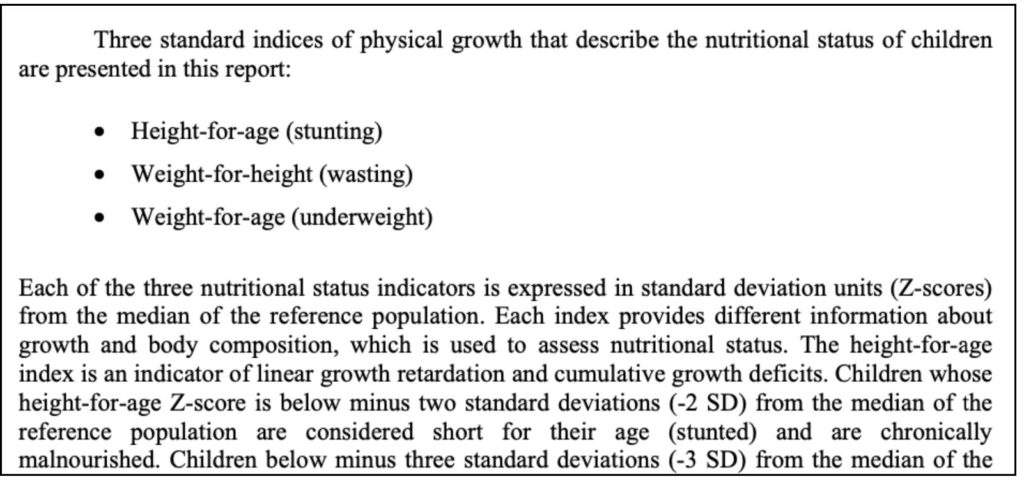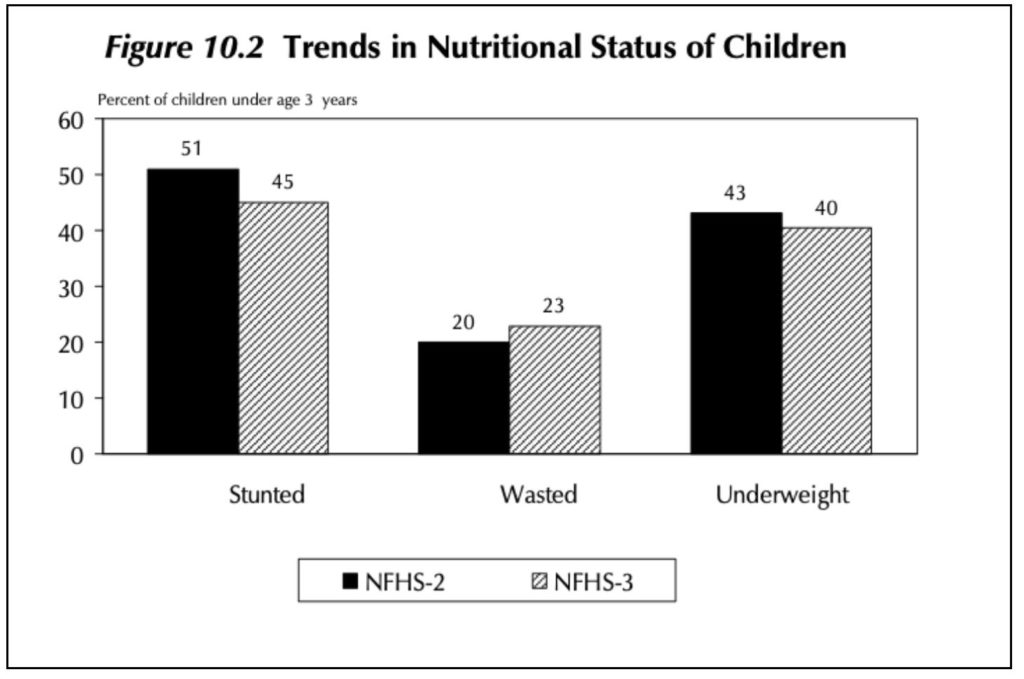Over the last 15 years, India recorded a significant improvement in the case of malnourished children under the age of 5. The proportion of stunted children decreased from 48% to 34.7% and underweight children from 42.5% to 33.4%. However, concerns remain when India is compared on the global scale.
The COVID-19 infection and the subsequent lockdown which was imposed in the country has had a varying impact on many sections of the population, especially among the less privileged. The contraction in economy has led to loss of livelihood and tightening up of the already scarce resources impacting their sustenance. The impact could be greater on children from these communities, not only because of the impact on their families but also because of the disruption to the support mechanism including mid-day meals in schools, nutritious food & health care in Anganwadis etc.
The UNICEF cites a study by John Hopkins Bloomberg School of Public Health, where it is estimated that the impact COVID-19 could result in additional 1.2 million deaths of under 5 age children globally. UNICEF also estimates that 36 million may go hungry across the world and around 370 million children may miss out on nutritious school meals, due to the disruptions caused by spread of COVID-19 infection.

While we need to wait to understand the impact of COVID-19 on the health & nutrition of children in India, we take a look at the existing information to understand the state of malnutrition of children in India and the trends over a period of time.
Improving trend at national level on various indices of nutritional status
The National Family and Health Survey (NFHS) provides baseline information on few critical aspects relating to Family & Health Indicators in the country. The Nutritional status of children is one of the key information provided as part of the NFHS.
As per the standards adopted by World Health Organization(WHO), NFHS considers 3 indices to define the nutritional status in children.
- Stunting – those with lesser height for a particular age
- Wasting – those with lower weight for a particular height
- Underweight – those with lower weight for a particular age

The latest NFHS report was published in 2015-16 as part of the NFHS-4. The earlier iterations were NFHS-3 (2005-06), NFHS-2 (1998-99) & NFHS-1 (1992-93).
As per NFHS-4, about 38.4 % of the children in India under the age of 5 years are stunted. This is an improvement compared to 10 years ago. The NFHS-3 in 2005-06 reported that about 48% of the children under 5 in India had a stunted growth. About 35.7 % of the children under 5 years are estimated to be ‘Under-weight’ as per NFHS-4 estimates, which is a slight improvement over the 42.5 % reported in NFHS-3 estimates. However, the situation deteriorated for other index i.e. ‘wasted’, where in 21% of the children under five years are estimated to be of lesser weight than expected for their height as per NFHS-4 compared to 19.8% in the NFHS-3.
The criteria of consideration of children for the survey was modified during NFHS-3, where in all the children under the age of 5 were eligible to be measured. This was not the case in the earlier two surveys, where in only the last two children under the age of three years were measured. Hence it is not appropriate to compare the numbers for NFHS-3 & NFHS-4 with NFHS-1 & NFHS-2. Nevertheless, NFHS-3 provides for a comparison with the earlier surveys for the three indices for children under the age of 3.
The numbers show that the trends across the indices observed in NFHS-4 is a continuation from earlier trends, where in the proportion of children who are stunted & underweight has come down, while the ones ‘wasted’ has increased.

Responding to a question in Lok Sabha on 23 September 2020, the government stated that the situation has improved compared to NFHS-4. This statement was based on the findings of Comprehensive National Nutritional Survey (CNNS) 2016-18.
As per CNNS 2016-18, the prevalence of stunting among children under the age of 5 reduced to 34.7% while under-weight children constituted 33.4% of the total children under the age of 5 in India. The survey also indicates that the situation of children who are categorized as ‘wasted’ has improved, contrary to the trends in the previous surveys.
Bihar, Gujarat, UP & MP have a higher proportion of Stunted children despite a marked improvement
Variances exists among the states with respect to these malnutrition indices. As per NFHS-3 in 2005-06, a total of 5 states in India each had more than half of the children under the age of 5 being ‘Stunted’. These include U.P (56.8%), Bihar (55.6%), Meghalaya (55.1%), Chhattisgarh (52.9%), Gujarat (51.7%), closely followed by MP (50%) and Jharkhand (49.8%).
Another 11 states each had 40% of the children with a stunted growth. Even for the comparatively better performing state of Kerala, nearly a quarter (24.5%) of the children under the age of five had a stunted growth. By the next round of survey i.e. NFHS-4 in 2015-16, the situation improved across all the states, with none of the states having more than 50% of children under 5 having a stunted growth. Of all the states, the five states of UP, Bihar, Meghalaya, MP & Jharkhand each had more than 40% stunted children. Remarkably, three states i.e. Kerala, Goa and Tripura had less than a quarter of children suffering from this type of malnutrition.
By the time of CNNS 2016-18, only Bihar and Meghalaya have estimated more than 40 % of children under 5 years, being stunted due to malnutrition.
Over these three surveys, Jammu & Kashmir has shown the most improvement with only 15.5% of children being categorized as stunted as per CNNS survey, better than Kerala, Goa & Tamil Nadu. However, this survey also shows one of the better performing state of Tripura showing increase in the proportion of children categorized as stunted.
M.P, Uttarakhand & Meghalaya among states which have improved the most in the proportion of underweight children
As per NFHS-3 in 2005-06, Madhya Pradesh (60%) with was the worst performing state in terms of proportion of children under 5 who are ‘Underweight’. A decade later, MP was able to reduce it to 42.8% by the time of NFHS-4 in 2015-16, which further decreased to 38.7% as per the estimates of CNNS between 2016-18. Its position as the state with highest proportion of children under 5 years being underweight is occupied by Jharkhand by the time of CNNS with 42.9%. However, Jharkhand did improve compared to NFHS-3 where-in 55.9% of children under 5 were underweight.
Uttarakhand managed to nearly halve the proportion of underweight children under 5 years. Barring Andhra Pradesh, Telangana & Delhi, every state was able to reduce the proportion of underweight children from NFHS-3 to CNNS (2016-18). There is a slight increase in the proportion of underweight children for these three states.
While there is an improvement over the years, India ranks among the countries with highest population of children suffering from malnutrition
In response to a Lok Sabha on 23 September 2020, the government highlighted the various initiatives taken up the government to tackle the challenge of malnutrition among children. These include provision of Supplementary Nutrition under Anganwadi Services of Umbrella Integrated Child Development Services (ICDS). Other initiatives include – POSHAN Abhiyaan, Pradhan Mantri Vandana Yojana (PMMVY), Scheme for Adolescent Girls (SAG) etc. aimed at supplementing both immediate and longer-term nutritional needs.
The results of these initiatives are visible in the improvement across each of the states. Although the proportion of children suffering from malnutrition as measured by various indices vary largely among the states, the trend over the past two decades has been of improvement across the states.
In spite of the significant improvement in the last 15 years, India’s situation is still grim when compared on a global scale. As per the Global Nutrition Report – 2018, India is among the 100 countries which is not on track for at least one of the Nutrition targets including – Child overweight, child wasting, child stunting etc. By the time of Global Nutrition Report – 2020, it continued to be one among the countries with zero targets on track (88 countries). Meanwhile, China & South Africa with which India has a close association as one of leading developing nations through BRICS, have fared better with being on track in at least two of the three indicators. While Russia is categorized in the same group as India, most of the countries who are not on track include African and other lesser developed nations.
Featured Image: Malnutrition in Children


